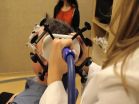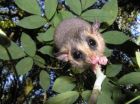(Press-News.org) A herbal preparation prescribed by a Chinese herbal medication practitioner in Melbourne for back pain resulted in life-threatening heart changes, prompting a team of intensive care and emergency physicians to call for appropriate patient education by practitioners who prescribe complementary medications.
Writing in Emergency Medicine Australasia, the journal of the Australasian College for Emergency Medicine, emergency medicine trainees Dr Angelly Martinez and Dr Nicky Dobos from the Intensive Care Unit at the Royal Melbourne Hospital and emergency medicine trainee Dr Joe-Anthony Rotella and emergency physician Dr Shaun Greene from Austin Health, described the case of a woman who began experiencing facial tingling and numbness within minutes of ingesting a preparation containing aconite.
These symptoms were followed by nausea, vomiting, diarrhoea and abdominal pain 30 minutes later.
Aconite is a class of plant that is also known as wolfsbane or devil's helmet.
The patient was given verbal instructions by the Chinese herbal medicine practitioner to boil the mixture of plant and animal material for 45 minutes prior to ingestion, although she boiled it for only 30 minutes.
By the time she was admitted to the emergency department, she had developed severe cardiovascular toxicity, which required admission to the intensive care unit.
"Aconite poisoning is not a toxicological condition that many Australian doctors would be aware of and has not been described in Australian peer reviewed medical literature for over 20 years," said Dr Shaun Greene.
"The case serves as a reminder that clinicians can access expert poisoning advice from a clinical toxicologist via the Poisons Information Centre system accessible via telephone (13 11 26) throughout Australia."
The Chinese herbal practitioner reported prescribing "Chuan Wu", "Cao Wu" and "Fu Zi" to improve general circulation and reduce musculoskeletal pain.
There is no commercially available biological assay for aconite in Australia.
"Chuan Wu", "Fu Zi" (both derived from Aconitum carmichaeli) and "Cao Wu" (Aconitum kusnezoffii), are the most common forms of aconite used medicinally.
This case illustrates the potentially lethal nature of aconite poisoning.
Chinese herbal medicines are being used increasingly in Australia, as the Chinese immigrant population increases.
"Regulatory agencies should enact measures to ensure patients are provided with accurate advice regarding safe use of Chinese herbal medicines," Dr Greene said.
INFORMATION: END
Deadly remedy: Warning issued about Chinese herbal medicine
2014-08-28
ELSE PRESS RELEASES FROM THIS DATE:
Are cigarette substitutes a safe alternative? It depends on user habits
2014-08-28
CORAL GABLES, Fla (Aug. 26, 2014)-- Cigarette smoking kills approximately 440,000 Americans each year, according to the Centers for Disease Control and Protection. It's the leading cause of preventable death worldwide. In order to overcome this addiction, many people resort to nicotine replacement therapies.
A recent literature review study by researchers at the University of Miami (UM) suggest that small dosages of nicotine found in cigarette substitutes could be harmful to human musculoskeletal system, due to overuse. The findings are reported in the Global Journal ...
From bite site to brain: How rabies virus hijacks and speeds up transport in nerve cells
2014-08-28
Rabies (and rabies virus, its causative agent) is usually transmitted through the bite of an infected animal into muscle tissue of the new host. From there, the virus travels all the way to the brain where it multiplies and causes the usually fatal disease. An article published on August 28th in PLOS Pathogens sheds light on how the virus hijacks the transport system in nerve cells to reach the brain with maximal speed and efficiency.
Pathogens that travel in the blood can spread throughout the body without much effort, courtesy of the heart's pumping action. Those traveling ...
Genomic sequencing reveals mutations, insights into 2014 Ebola outbreak
2014-08-28
In response to an ongoing, unprecedented outbreak of Ebola virus disease (EVD) in West Africa, a team of researchers from the Broad Institute and Harvard University, in collaboration with the Sierra Leone Ministry of Health and Sanitation and researchers across institutions and continents, has rapidly sequenced and analyzed more than 99 Ebola virus genomes. Their findings could have important implications for rapid field diagnostic tests. The team reports its results online in the journal Science.
For the current study, researchers sequenced 99 Ebola virus genomes collected ...
Radio telescopes settle controversy over distance to Pleiades
2014-08-28
Astronomers have used a worldwide network of radio telescopes to resolve a controversy over the distance to a famous star cluster -- a controversy that posed a potential challenge to scientists' basic understanding of how stars form and evolve. The new work shows that the measurement made by a cosmic-mapping research satellite was wrong.
The astronomers studied the Pleiades, the famous "Seven Sisters" star cluster in the constellation Taurus, easily seen in the winter sky. The cluster includes hundreds of young, hot stars formed about 100 million years ago. As a nearby ...
New research reveals how wild rabbits were genetically transformed into tame rabbits
2014-08-28
The genetic changes that transformed wild animals into domesticated forms have long been a mystery. An international team of scientists has now made a breakthrough by showing that many genes controlling the development of the brain and the nervous system were particularly important for rabbit domestication. The study is published today in Science and gives answers to many genetic questions.
The domestication of animals and plants, a prerequisite for the development of agriculture, is one of the most important technological revolutions during human history. Domestication ...
Electric current to brain boosts memory
2014-08-28
VIDEO:
Stimulating a region in the brain with non-invasive electrical current using magnetic pulses (Transcranial Magnetic Stimulation) improves memory, reports a new Northwestern Medicine study in Science. The discovery opens...
Click here for more information.
CHICAGO --- Stimulating a particular region in the brain via non-invasive delivery of electrical current using magnetic pulses, called Transcranial Magnetic Stimulation, improves memory, reports a new Northwestern Medicine® ...
Less than $200 million would conserve precious Atlantic Forest in Brazil, say researchers
2014-08-28
Brazil could conserve its valuable Atlantic Forest by investing just 0.01 per cent of its annual GDP, according to a new study.
The Atlantic Forest (Mata Atlântica) is one of the most important and threatened biodiversity hotspots in the world, containing the only living examples of nearly 10,000 species of plant and more bird species than all of Europe.
Situated along the Atlantic coast of Brazil, it once covered an area of nearly 1.5 million square kilometres. Today, the forest is home to more than 130 million people and it covers only 160,000 km2, because of deforestation. ...
Home is where the microbes are
2014-08-28
A person's home is their castle, and they populate it with their own subjects: millions and millions of bacteria.
A study published today in Science provides a detailed analysis of the microbes that live in houses and apartments. The study was conducted by researchers from the U.S. Department of Energy's Argonne National Laboratory and the University of Chicago.
The results shed light on the complicated interaction between humans and the microbes that live on and around us. Mounting evidence suggests that these microscopic, teeming communities play a role in human ...
New DNA study unravels the settlement history of the New World Arctic
2014-08-28
We know people have lived in the New World Arctic for about 5,000 years. Archaeological evidence clearly shows that a variety of cultures survived the harsh climate in Alaska, Canada and Greenland for thousands of years. Despite this, there are several unanswered questions about these people: Where did they come from? Did they come in several waves? When did they arrive? Who are their descendants? And who can call themselves the indigenous peoples of the Arctic? We can now answer some of these questions, thanks to a comprehensive DNA study of current and former inhabitants ...
Penn-NIH team discover new type of cell movement
2014-08-28
VIDEO:
Penn and NIH researchers have demonstrated a never-before characterized type of cell movement. In this video, a cell's vimentin cytoskeleton (green) pulls the nucleus (red) forward to generate a high-pressure...
Click here for more information.
For decades, researchers have used petri dishes to study cell movement. These classic tissue culture tools, however, only permit two-dimensional movement, very different from the three-dimensional movements that cells make in a ...



